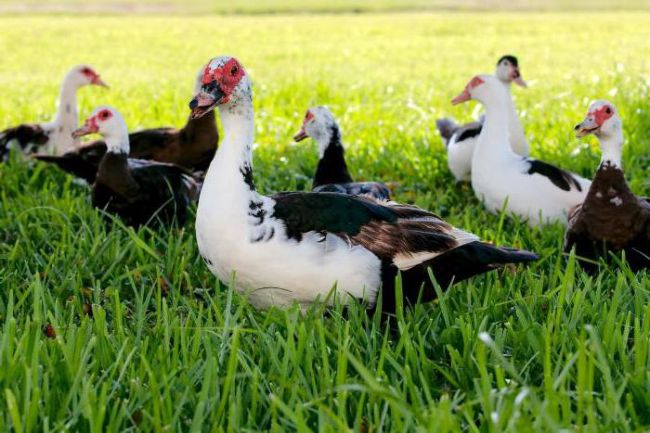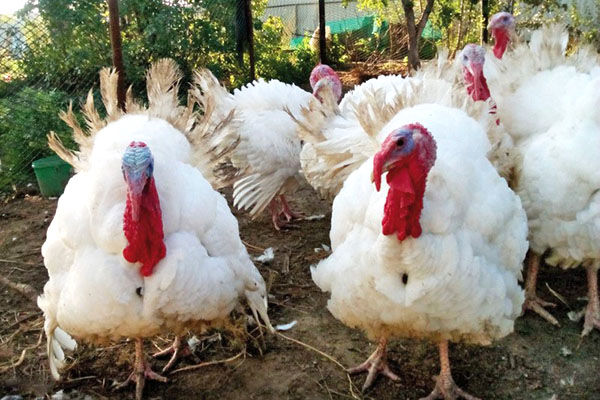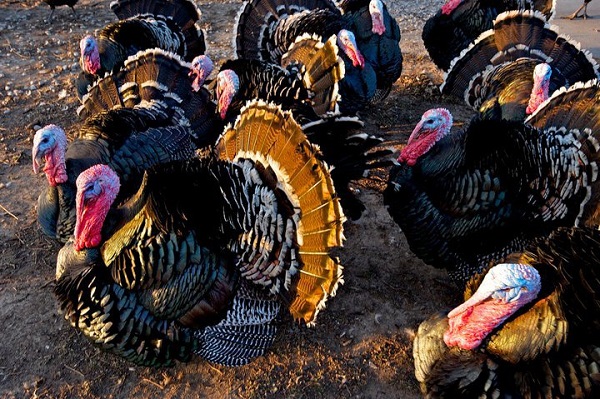The heavyweight Big 6 turkeys appeared relatively recently, in 2008 this breed was obtained by breeding in the UK. Russian farmers liked the poultry, a large percentage of meat and low maintenance costs make growing at home economically viable.
Content
External description of a turkey
Large and heavy birds with a tiny head have a chic, fluffy plumage, which has no less value than meat. If the turkey is angry, its fluff stands on end, and it becomes like a white ball. The bird has sinewy and strong legs, as well as strong wings, so they are recommended to be trimmed. A distinctive feature of individuals is the neck, equipped with red folds, they are called corals. A leather bag hangs on the top of the beak; at the time of excitation, it can increase to 15 cm.
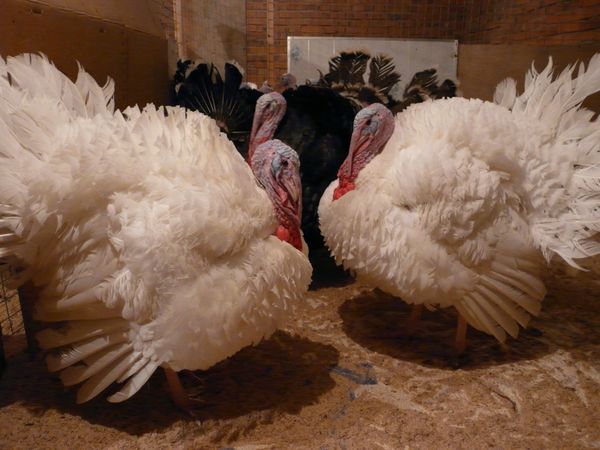
The bird has a rather aggressive character and will not be offended, but with chickens or ducks, it is better to keep it separately, in order to avoid fights and injuries.
Characteristics of the cross 6 Big
The weight of a mature turkey is 25 kg, females are much lighter, they reach 11 kg. The meat yield is 80% of body weight, due to this their attention is paid to breeding. Turkeys begin to lay eggs from 7 months, and in a year their number reaches 100 pieces, each weighs about 80 g. The nesting period is 26-28 days.
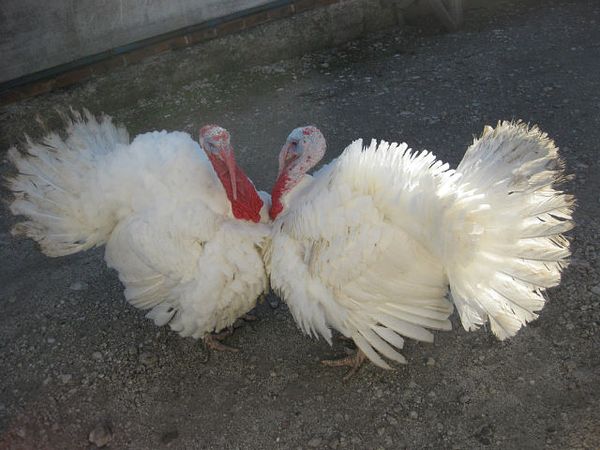
Besides:
- hatchability of eggs - 85%;
- slaughter yield - 70-75%;
- muscle mass - 80%.
To grow 1 kg of live meat, it is necessary to spend 2 kg of feed, and a turkey needs 250-350 g per day. Poultry slaughter is carried out in 3-4 months, because it is not practical to keep it further, as growth stops.
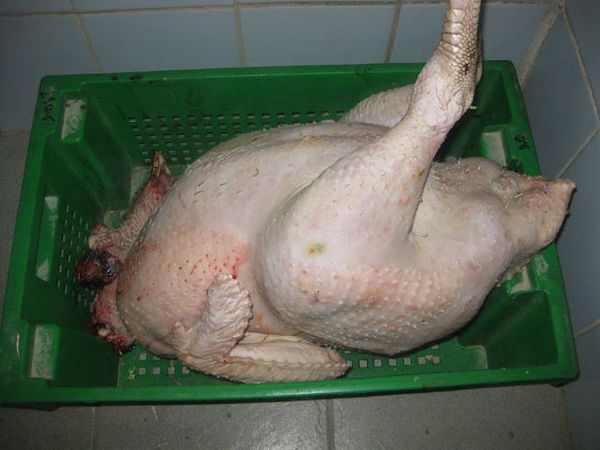
Breeding turkeys Big 6
Forbreeding individuals should be equipped with a stationary and indoor chicken coop, in winter the temperature should be at the level of 18-20 degrees. Little turkeys need a warmer routine. Turkeys do not tolerate temperature fluctuations, so you need to create the same climate throughout the year. Small tips to help grow healthy offspring at home:
- Necessarily the presence in the house of lamps, artificial lighting, the longer the daylight hours, the better the females rush. If you install an automatic system, the process of bird care will be greatly simplified.
- There should be a sufficient number of feeders and drinkers in the room, otherwise some birds will starve, which will negatively affect weight gain. And also this drawback can cause fights among individuals, which will negatively affect their health.
- Periodically, turkeys need to clean their plumage, in order to avoid the appearance of parasites, they perform this process with the help of sand and ash, so the house must have bathtubs with these materials.
- It is necessary to maintain hygiene in the cells, for this the litter of sawdust or straw should be changed at least 1 time in 3-4 days.
- To avoid dampness, we ventilate the barn even in winter.
- When calculating the size of the room, it should be assumed that 2 individuals need 1 sq.m. space.
- The presence of thick, wooden perches is mandatory.
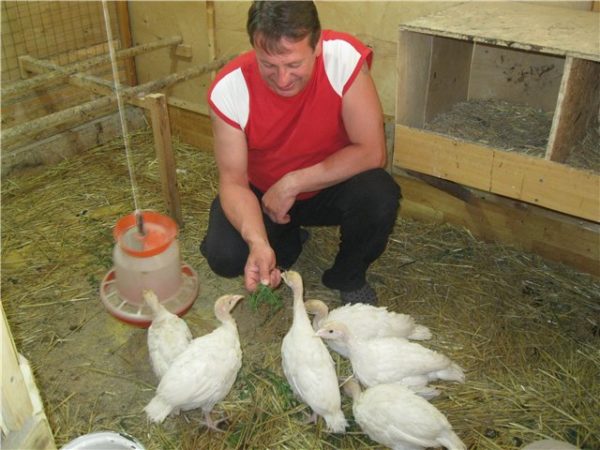
In warm time, birds are in the fresh air, and at night they are driven into a chicken coop.
Feeding and maintenance
Eating should be carried out 3 times a day, overfeeding them is dangerous, since turkeys are genetically prone to obesity. It is necessary to draw up a diet so that it contains a balanced set of products:
- At the initial stage, starting feeds are used, which allow you to get healthy, young offspring.
- Then, little by little grain crops are introduced; in the winter, shredded vegetables are necessarily added. As vitamins, fish oil, mountain ash are used. Dry food can be watered with milk or kefir. And to stimulate appetite, finely chopped onions.
- Wheat and oat flour, as well as ground needles, will help to increase weight faster.
- To strengthen bones, meat and bone meal is used.
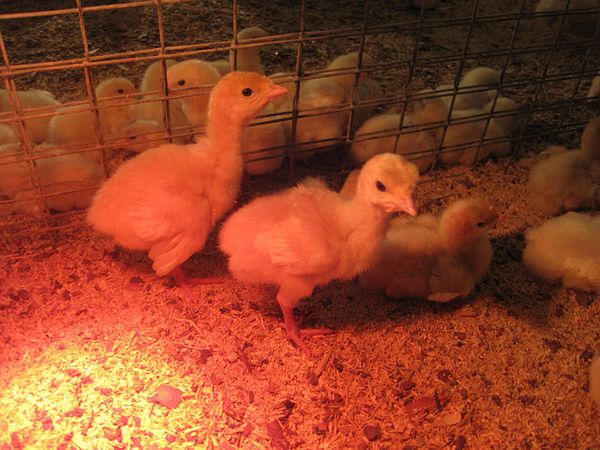
The maintenance of turkeys is quite an expensive pleasure, in addition to feed, you will have to spend money on medicines if the bird gets sick, but after the sale of meat all expenses will pay off.
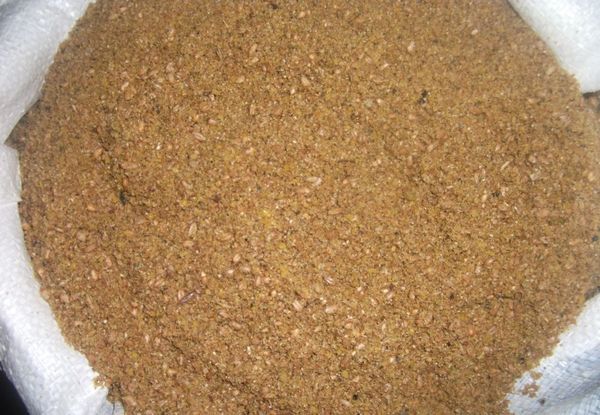
The nursery must be made spacious so that the turkey can eat all the food in one go. Before each meal, they must be washed in order to avoid infection.
How to cook feed yourself
The purchase of a factory product is unprofitable for a small farmer, so it is better to do it yourself. It should include the following elements:
- Proteins help the bird increase weight and height, a large number of them are found in cereals, beans, and beans.
- Fat helps maintain proper body temperature.
- Carbohydrates are found in green grass and starch.
- Surely fiber, its percentage should be 7-8 of the total mass of feed.
- Minerals help the development of tissues, they are found in meat and bone meal.
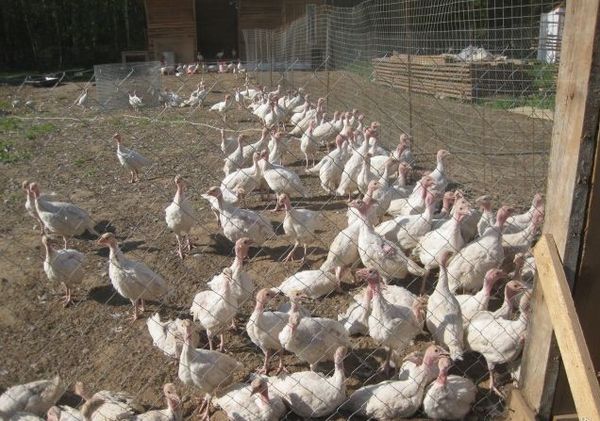
However, for proper preparation, it is necessary to observe the proportions of all ingredients, otherwise the result will be the opposite. Here are a few ways to prepare the feed, the proportion of products indicated on one copy per day:
- grain - 250 g;
- wheat bran - 60 g;
- corn, millet - 80 g;
- carrots, pumpkin, beets - 80 g;
- boiled potatoes - 100 g;
- waste from meat and fish - 150 g;
- meat and bone meal - 10 g;
- salt - 2 g;
- shell - 10 g.
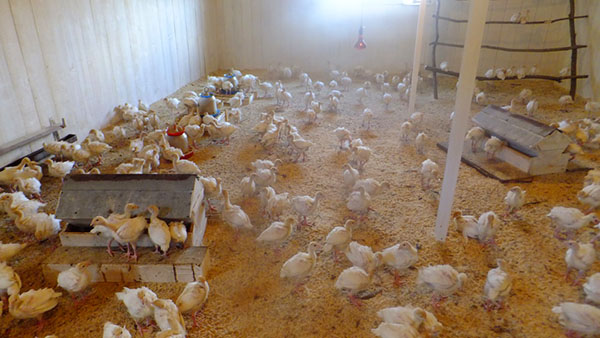
Another composition:
- millet - 70.5%;
- sunflower meal - 20.3%;
- shredded dry grass - 6%;
- feed yeast - 5%;
- fishmeal - 4%;
- limestone - 4%;
- chalk - 3%;
- table salt - 0.5%.
It is necessary to add chalk carefully, if you make a mistake with the grams, it will stray and damage the bird’s stomach. Replacing wheat with barley is likely to cause obesity.

Breeding chickens is not a difficult task, as they are unpretentious. The main task is feeding the chickens, ...
Growing turkey poultry Big 6
To breed birds, this breed is not difficult, if you follow the prescribed rules. Most often you have to do this from eggs, because it’s almost impossible to buy chickens. But their hatchability is very good and reaches 85%, so all the money back is more than returned. Many farmers try to remove the chicks from the eggs of their turkeys, however, they may not be fertilized.
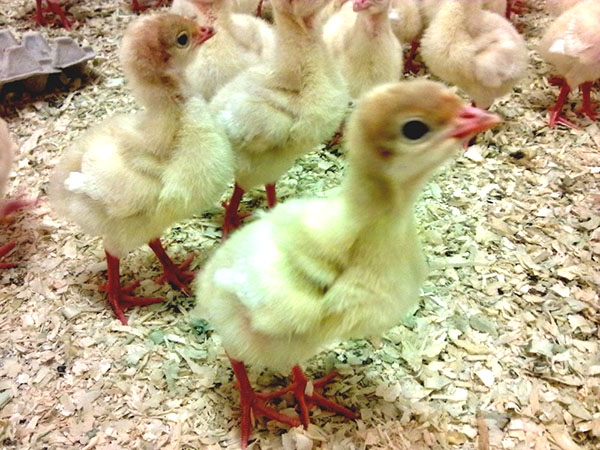
It is impossible to answer unequivocally to the question, at what time is it better to bookmark the incubator. It all depends on when you need meat, you should know that the bird gains maximum weight in 3-4 months.
Fertilization is checked by ovoscope, the incubation process proceeds in the same way as in chickens. But leaving home for turkey poultry requires more patience.Up to a week, chickens do not tolerate temperature jumps, 32-35 degrees will be ideal. At the same time, it is better that heat comes from below. During the second week, it can be reduced to 27-29.
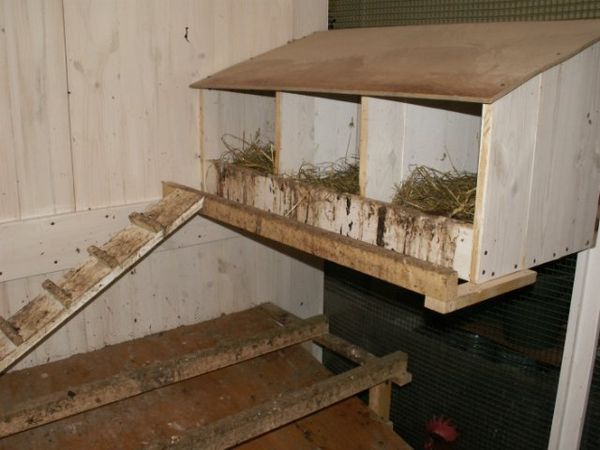
High temperature will provoke heat stroke in chicks or slow growth. The most difficult period is up to two months, after which all fears can be discarded, now the chicks will only gain weight.
Most of all, a little turkey is afraid of moisture, so you should not insulate the floor with fabric products, as they instantly absorb moisture. It is better to take hay or dry grass, but it is advisable not to use sawdust, since they are very dirty. In addition, the chicks can start to peck them, and thereby bring the infection into their stomach.
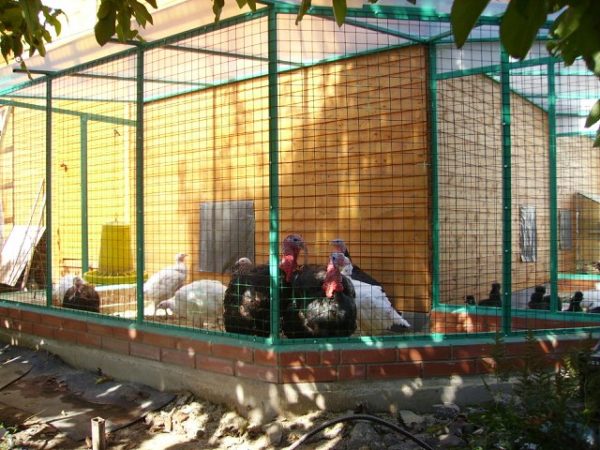
What you need to remember when choosing feeders and drinking bowls for chicks:
- You should wash them before each meal.
- Nurseries should be installed as much as possible so that the turkey poults do not crowd around them, otherwise some will be malnourished, as a result of which they will lose weight.
- Drinkers choose wide, they must also be carefully fixed so that the chicks do not tip the water over. A wet chick can catch a cold and die, even if saved, it will still grow poorly.
- It is strictly forbidden to use metal feeders, as a turkey can damage the beak.
They are taught to such tanks slowly and systematically.
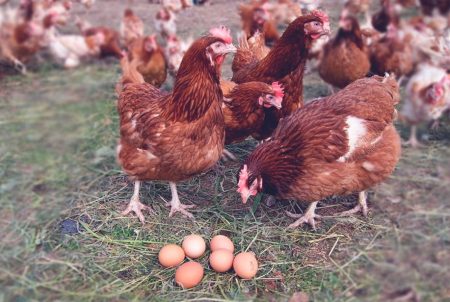
An overview of the breeds of egg-laying hens with photos and a description
Breeding chickens begins with the selection of breeds, which are divided into egg and meat. The name of the breed variety ...
Feeding rules
If a mash is used for food, then it must be ensured that it is not very wet. To do this, squeeze it in a fist and let it go, if there is a lump in the palm of your hand, then there is too much water, it has scattered, which means that the proportion is normal. The chickens will eat the wet mix easily, but wet porridge can clog the goiter, and then deterioration is possible.
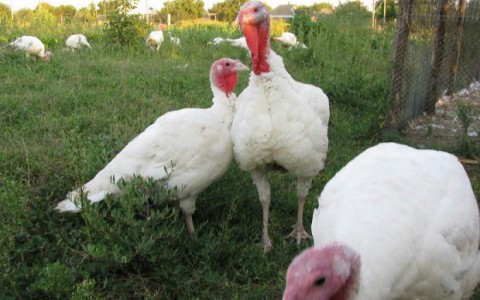
At the very beginning, the turkeys are given starter feed, and for a period of 15-20 days, boiled eggs, greens, and fermented baked milk are added. The following products are a part of mixers:
- corn;
- wheat grains;
- barley;
- meat and bone meal;
- green onions;
- nettle;
- garlic leaves;
- dandelion.
This composition provides good health for the chicks, but disease prevention still needs to be carried out.
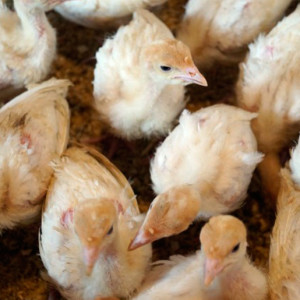
From the first to the third day, vitamin C should be included in the diet of chickens, for this we add 2 g per 10 liters of liquid. From 6 to 11, it is necessary to drink a course of antibiotics, for example, Tilan, it is mixed in such a way, 5 g of medicine is taken for 10 liters of water. After a month, repeat this procedure. At the age of the week, vitamin D3 must be included in the chicken menu.
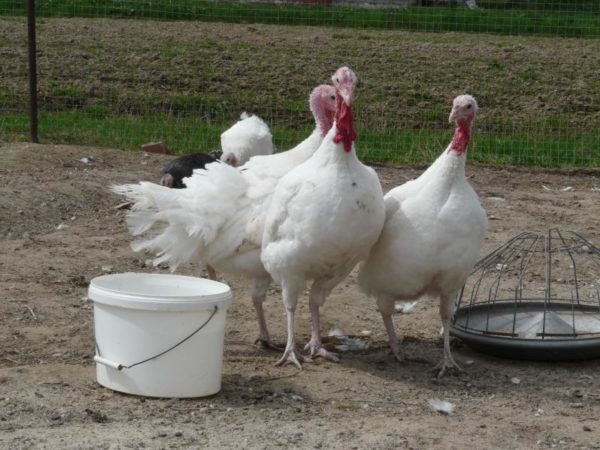
To increase the immunity of birds after taking antibiotics, we give the Chiktonik amino acid complex, for 7 days, at a dose of 1 ml per 2 liters of water, morning and evening.
Such procedures will allow you to grow strong and healthy birds.
Features of meat turkeys breed Big 6
Breeders experimented with the creation of a new breed that exceeds the performance of Big 6, but so far this has not been possible. Consider the advantages of this individual:
- Large mass, adult males reach 25 kg.
- At low cost for fattening, fast weight gain.
- There are few bones, meat yield from the whole carcass is 80%, of which 30% is breast.
- Elegant plumage, in demand in production.
- Over the entire period, the female carries about 100 eggs, which is not observed in other breeds.
- The meat is dietary and is perfectly absorbed by the human body.
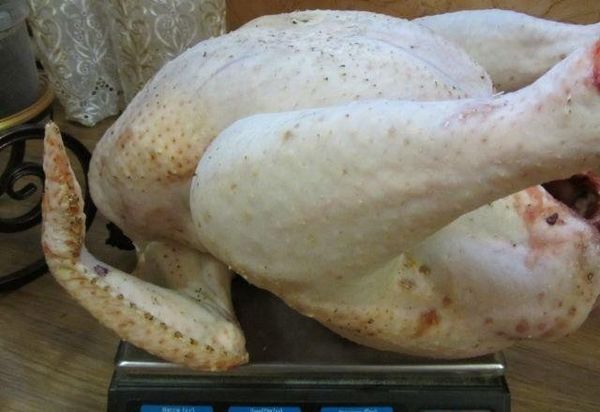
Naturally, there are drawbacks, but, according to farmers who have long grown turkeys, the profit from the sale of meat covers them handsomely:
- Feathered heat-loving, therefore, additional heating of the house in winter is necessary.
- To maintain cleanliness will require a lot of sawdust and straw.
- Heavy males cannot fertilize the female, therefore it is necessary to produce this process artificially.
- The pugnacious nature of the birds makes them keep their families in individual cages.
It seems to some that growing turkeys is a rather troublesome task, but in principle it is no different from keeping chickens or ducks, and there is much more finished meat. Details of the care and maintenance of individuals can be seen on the video.
Major diseases
The most dangerous and deadly, especially for babies, is Newcastle disease. It is determined by the appearance of mucus in the goiter, as well as loose stools, gray-green in color. It is incurable, it can only be prevented, for this, at the age of 14 and 28 days, the turkeys are given a vaccine.
Aspergillotoxicosis can occur with poor nutrition or due to dirty and rotten litter. The bird becomes lethargic, appetite disappears, and rapid breathing appears. Death most often occurs suddenly and is accompanied by convulsions. At the first symptoms, it is necessary to replace the litter and mixed feed, add foods of dairy origin to the food.
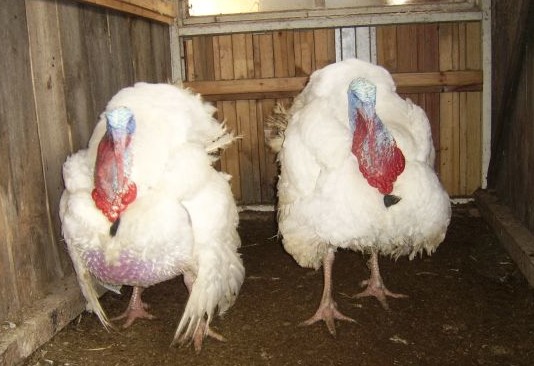
Respiratory mycoplasmosis is rarely fatal, however, it is better to treat it with a veterinarian. The main symptoms are coughing, wheezing, swollen eyes, and stunted growth.
Histomoniasis in the chick affects the liver and cecum and is accompanied by yellow-green diarrhea. The cause of the disease lies in unsanitary conditions in the cell. The treatment is carried out by a veterinarian.

